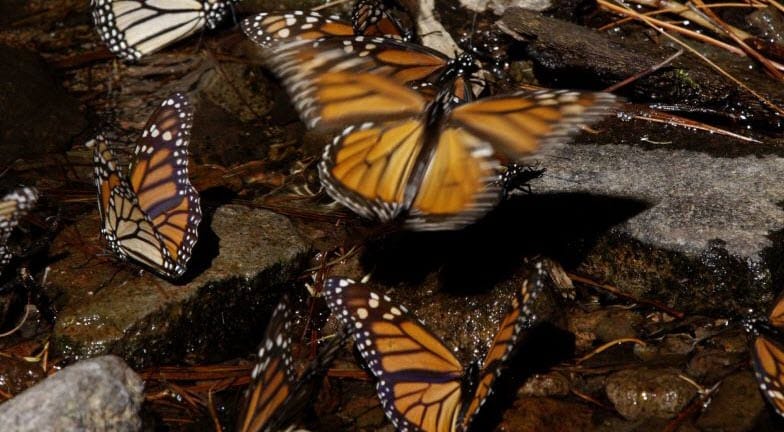Another Danger Sign for Texas Wildlife: Monarch Numbers in Mexico Hit Record Low

The existence of Monarch butterflies, shown in Mexico, is threatened, scientists say, by manmade changes in their main food source and protective habitat.
MEXICO CITY — The stunning and little-understood annual migration of millions of Monarch butterflies to spend the winter in this country is in danger of disappearing, experts said Wednesday, after numbers dropped to their lowest level since record-keeping began in 1993.
The report blamed the displacement of the milkweed the species feeds on by genetically modified crops and urban sprawl in the United States, extreme weather trends and the dramatic reduction of the butterflies’ habitat in Mexico because of illegal logging of the trees they depend on for shelter.
After steep and steady declines in the previous three years, the black-and-orange butterflies now cover only 1.65 acres in the pine and fir forests west of Mexico City, compared to 2.93 acres last year, said the report released by the World Wildlife Fund, Mexico’s Environment Department and the Natural Protected Areas Commission.
They covered more than 44.5 acres at their recorded peak in 1996.
Because the butterflies clump together by the thousands in trees, they’re counted by the area they cover.
While the Monarch isn’t in danger of extinction, the decline in their population now marks a statistical long-term trend, experts said.
Lincoln Brower, a leading entomologist at Sweet Briar College in Virginia, wrote that “the migration is definitely proving to be an endangered biological phenomenon.”
“The main culprit,” he wrote in an email, is genetically modified “herbicide-resistant corn and soybean crops and herbicides in the USA,” which “leads to the wholesale killing of the monarch’s principal food plant, common milkweed.”
While Mexico has made headway in reducing logging in the officially protected winter reserve, that alone can’t save the migration, wrote Karen Oberhauser, a professor at the University of Minnesota.
“A large part of their reproductive habitat in (the Midwest) has been lost due to changes in agricultural practices, mainly the explosive growth in the use of herbicide-tolerant crops,” Oberhauser said.
Extreme weather — severe cold snaps, unusually heavy rains or droughts in all three countries — also apparently have played a role.
But the milkweed issue now places the spotlight firmly on the United States and President Barack Obama, who is scheduled to visit Mexico on Feb. 19. Events on that trip are scheduled for Toluca, a city near the butterfly reserve.
It’s unclear what would happen to the Monarchs if they no longer made the annual trek to Mexico, the world’s biggest migration of Monarch butterflies and the second-largest insect migration, after a dragonfly in Africa.
There also has been a movement in the United States among gardeners and home owners to plant milkweed to replace some lost habitat. But activists say large stands of milkweed are needed along the migratory route.
NOTES:
– article appeared in the 1/29/2014 online edition of the San Antonio Express News
-Photo is taken from Google Images, original is via NatHab.com
Poisons Are Safe?
In the debate surrounding GMOs, the agribusiness companies are in “full spin mode,” attempting to gloss over the real affects of genetic manipulation. According to them, GMOs offer an opportunity to hybridize plants, increasing resistance to a host of threats including drought and parasites. According to them, mankind’s recent ability to identify and manipulate genes is just a natural and more efficient extension of traditional crossbreeding that is as old as agrarian civilization.
While it is naïve to assume that all of these efforts are harmless, or that the agribusiness companies or their cronies in government and academia would blow the whistle on a danger, theoretically, precise hybridization holds much promise.
Unfortunately, the developers of GMOs have veered from this potentially beneficial path and have focused their efforts on modifying food crops such as corn and soybeans to tolerate high levels of poisons, which are then put on all our croplands. To justify the development of these poison-tolerant plants, which benefits their bottom lines, university/agribusiness alliance experts generate copious amounts of testimony “proving” that cropland and rangeland poisons are not dangerous.
The experts avoid discussing the unintended consequences of mass poisoning, such as that highlighted in the above article. The poisons are wiping out plants on which insects and soil organisms depend and unraveling a complex web of life. Because the strands of the web are interwoven, we can be sure it is affecting larger animals, including wildlife and habitats.
Skeptics might respond that worrying about a butterfly is like worrying about a snail darter or some other esoteric, “unimportant” animal or niche, but they miss the point. By expanding the use of these poisons, we are launching a massive attack on overall biodiversity.
This article refers only to Roundup®. But, because Roundup® has produced super weeds, the new “solution” is a super poison: 2,4-D, a basic building block of Agent Orange. The government, agency and university cronies of the agribusiness giants say that 2,4-D is harmless, just like Roundup®. If so, why is our government paying disability to 80,000 Viet Nam veterans and considering 72,000 additional disability claims from former soldiers exposed to these chemicals during the war?
Agribusiness and its allies will tell you that Roundup® is only active for about a year, but this is not true. These poisons have long residual lives in surface and sub-surface water.
Saying that Roundup ® or its 2,4-D replacement is only effective for a year is like saying a pistol bullet is only lethal for 30 seconds. Tell that to whatever got shot.
Once you kill out a community of plants and animals, they stay dead.
